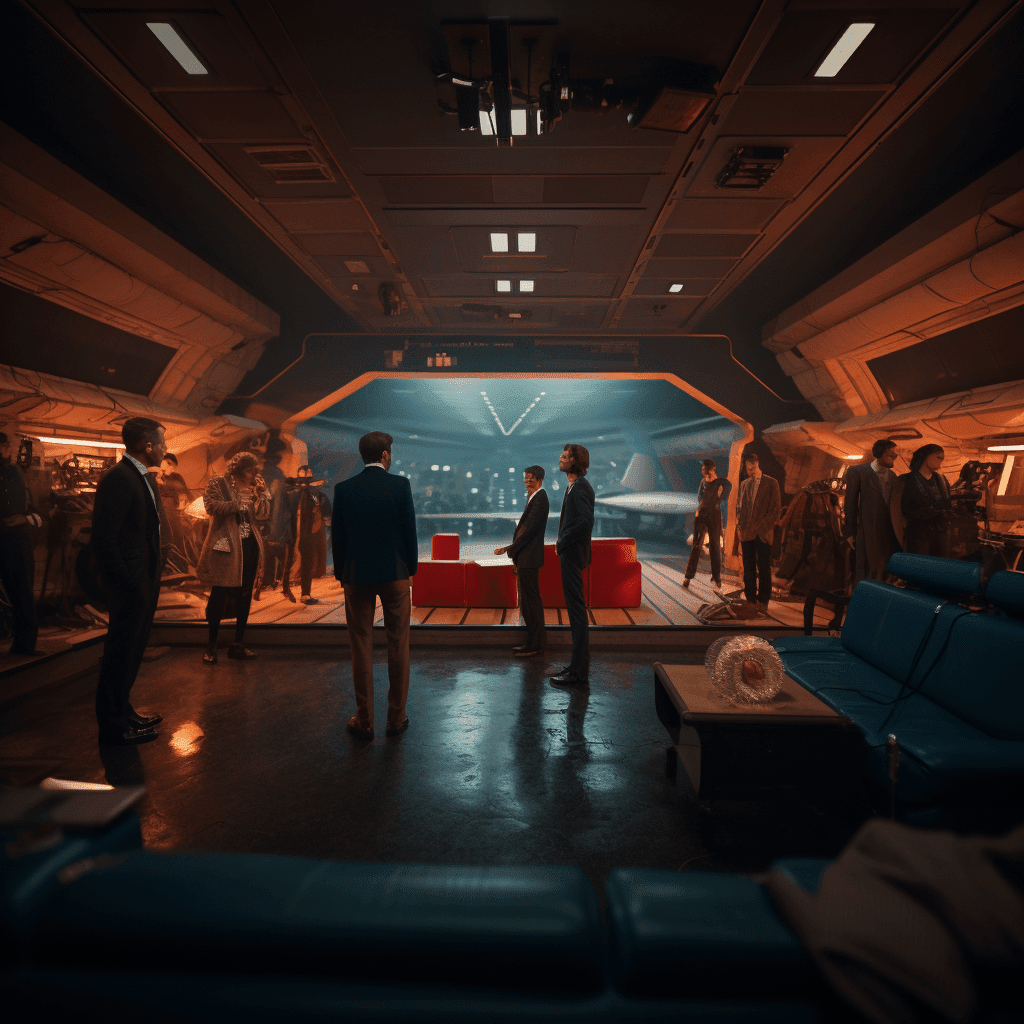What's After the Blog?
Genres • History
The Renaissance of Musical Films in Contemporary Cinema
Explore the captivating resurgence of musical films in modern cinema, from their historical roots to their profound impact on contemporary audiences and the music industry.
May 27, 2024

The Renaissance of Musical Films in Contemporary Cinema
Introduction
The musical film genre, with its unique blend of storytelling, music, and dance, is experiencing a vibrant renaissance in contemporary cinema. This resurgence is not just a revival of a classic form but a reinvention, adapting to modern sensibilities and technological advancements. At What’s After the Movie (ATM) and The Sound of Music set a high bar in the golden age of Hollywood, weaving stories with memorable melodies. Today, films like La La Land and The Greatest Showman are breathing new life into the genre, infusing contemporary themes with innovative musical arrangements, and connecting with a whole new generation of moviegoers.
The appeal of modern musical films lies in their ability to offer escapism, nostalgia, and an emotional resonance that is amplified by music. They provide a form of storytelling that can uplift, inspire, and connect with audiences on a deeply emotional level. The resurgence of musicals also signifies a shift in cinematic trends, where audiences are seeking diverse and dynamic forms of storytelling. The modern musical film combines the allure of visual storytelling with the emotional power of music, creating a rich, immersive cinematic experience.
The Historical Context of Musical Films
Musical films have been a part of cinema since the advent of sound in movies. The genre reached its zenith in the mid-20th century, often referred to as the “Golden Age” of Hollywood musicals. This era saw the production of some of the most iconic musical films, which remain beloved to this day. Classics like Singin’ in the Rain and The Sound of Music are not just films but cultural landmarks, celebrated for their memorable songs, intricate choreography, and timeless stories. These films showcased the talents of legendary stars like Gene Kelly, Fred Astaire, and Julie Andrews, who became synonymous with the musical genre.
However, post the 1960s, the popularity of musicals waned as audience tastes evolved and new genres emerged. The musical film, with its often upbeat tone and stylized presentation, seemed out of sync with the more gritty and realistic style of filmmaking that was gaining traction. It wasn’t until the late 20th and early 21st centuries that we began to see a resurgence of interest in musical films. This renaissance has been marked by a blend of nostalgia for the classic form along with a desire to adapt and reinvent it for contemporary audiences.
Recent films like Mamma Mia! and Chicago have successfully bridged the gap between the old and the new, offering modern sensibilities while retaining the charm of classic musicals. These films have not only been commercial successes but have also garnered critical acclaim, indicating a renewed interest and appreciation for the musical genre in contemporary cinema. This resurgence is a testament to the enduring appeal of musical films and their ability to adapt to changing times while still providing a unique and enjoyable cinematic experience.
”Why Have Musical Films Become Popular Again?”
The resurgence of musical films in contemporary cinema can be attributed to several factors. Firstly, there’s a growing appetite for escapism in today’s fast-paced and often stressful world. Musicals, with their larger-than-life characters, vibrant settings, and catchy tunes, offer a perfect escape. They create a world where problems can be sung away and dreams can come true, resonating deeply with audiences seeking a break from reality. Films like La La Land and The Greatest Showman have captivated audiences with their blend of escapism and relatable storytelling, set against the backdrop of stunning musical numbers.
Nostalgia also plays a significant role in the renewed popularity of musicals. Many contemporary musicals pay homage to the golden age of Hollywood, bringing back the glamour and charm of old musicals but with modern twists. This blend of old and new appeals to a wide range of audiences, from those who grew up with classic musicals to younger generations experiencing the magic for the first time. Additionally, the emotional impact of music in storytelling cannot be understated. Music has the power to evoke emotions and connect with audiences on a deep level. When combined with compelling narratives, as seen in films like Les Misérables, the result is a powerful cinematic experience that stays with the viewer long after the credits roll.
Key Films in the Musical Renaissance
Several key films have played a pivotal role in the renaissance of musicals in contemporary cinema. La La Land, directed by Damien Chazelle, stands out for its creative storytelling, stunning cinematography, and homage to classic Hollywood musicals, while offering a fresh perspective on love and ambition in the modern world. Another significant film, The Greatest Showman, captivates audiences with its inspiring story, visually spectacular sequences, and memorable soundtrack, redefining the modern musical.
Les Misérables, a film adaptation of the popular stage musical, brought the genre to a new level of dramatic and emotional depth, with powerful performances and a raw, immersive approach to the musical format. Meanwhile, Mamma Mia! and its sequel brought a sense of joy and fun, combining popular ABBA songs with a light-hearted story that appealed to a broad audience.
These films, among others, have not only achieved commercial success but have also played a crucial role in bringing musicals back to the forefront of popular culture. They have demonstrated that the musical film genre is capable of evolving and adapting, able to tell diverse and compelling stories while maintaining the essence of what makes musicals so enchanting.
The Role of Technology in Modern Musicals
Advancements in technology have significantly influenced the production and presentation of modern musical films. The integration of cutting-edge visual effects, high-quality digital sound, and innovative filming techniques has allowed filmmakers to create more visually spectacular and sonically rich musical experiences. For instance, the use of advanced computer-generated imagery (CGI) in Beauty and the Beast enabled the creation of a fantastical, immersive world that complemented the film’s musical elements. Similarly, the live recording of vocals in Les Misérables offered a raw and authentic musical experience, deviating from the traditional method of lip-syncing to pre-recorded tracks.
The digital age has also expanded the reach of musical films through various online platforms, allowing for broader distribution and accessibility. Streaming services like Netflix and Disney+ provide a platform for both classic and contemporary musicals, introducing them to new audiences and keeping the genre alive and thriving. Moreover, social media platforms have become pivotal in promoting musical films, with movie soundtracks going viral on platforms like TikTok and YouTube, further embedding these films into popular culture.
The Integration of Diverse Music Genres
Contemporary musical films have embraced a wide range of music genres, reflecting the diverse musical tastes of modern audiences. This integration has brought a new dimension to the narrative and appeal of musicals. For example, Mamma Mia! successfully incorporated ABBA’s pop hits into its storyline, creating a joyful and nostalgic experience for viewers. The groundbreaking musical Hamilton, with its blend of hip-hop, R&B, and traditional show tunes, has redefined what a musical can be, appealing to a younger, more diverse audience and showcasing the universal power of music.
The use of various music genres in musical films has not only diversified the stories that can be told but has also broadened the audience base for musicals. It has allowed filmmakers to tell more contemporary and relatable stories through a medium that was once dominated by traditional show tunes. This evolution in musical storytelling has played a significant role in the renaissance of musical films, making them more accessible and appealing to a wider range of audiences.
In conclusion, the resurgence of musical films in contemporary cinema can be attributed to a combination of factors: a longing for escapism and nostalgia, the emotional power of music, advancements in technology, and the integration of diverse music genres. Modern musicals have successfully adapted to the changing times while maintaining their timeless charm, ensuring their place in the hearts of audiences for years to come.
”How Do Musical Films Impact the Music Industry?”
Musical films have a symbiotic relationship with the music industry, often leading to a significant impact on both sectors. The soundtracks of these films frequently become chart-topping hits, extending the movie’s influence beyond the cinema. For instance, the soundtrack of The Greatest Showman not only achieved commercial success but also became a cultural phenomenon, with songs like “This Is Me” resonating with audiences worldwide. Similarly, the soundtrack of La La Land received critical acclaim and widespread popularity, highlighting the power of music in storytelling.
The success of a musical film’s soundtrack can also lead to increased visibility for the artists involved. It often introduces new talents to a broader audience and revitalizes the careers of established artists. Additionally, the popularity of these soundtracks can influence musical trends and listener preferences, shaping the music industry’s landscape. The enduring appeal of certain musical films and their soundtracks also contributes to the longevity of the songs, often becoming timeless classics that continue to be celebrated years after the film’s release.
The Future of Musical Films
Looking to the future, the musical film genre appears to be on a trajectory of continued innovation and popularity. The evolving landscape of cinema, characterized by diverse storytelling and technological advancements, provides a fertile ground for the growth of musical films. Future musicals may see even more integration of varied music genres, reflecting the globalized and interconnected world we live in. Furthermore, advancements in virtual reality and immersive cinema experiences could open new avenues for how musical films are produced and experienced, offering even more engaging and interactive forms of storytelling.
The appeal of musical films is likely to endure, as they offer a unique combination of visual spectacle, emotional storytelling, and musical enjoyment. As audiences continue to seek diverse and creative forms of entertainment, the musical film genre will likely adapt and evolve, continuing to enchant and captivate moviegoers around the world.
In conclusion, the renaissance of musical films in contemporary cinema is a testament to the genre’s ability to evolve and resonate with modern audiences. From their impact on the music industry to their promising future, musical films continue to be a vital and vibrant part of the cinematic landscape.
Continue reading

What's After the Movie?
Not sure whether to stay after the credits? Find out!
Check out our other apps:
Actors
Companies
Latest Movies
© 2025 What's After the Movie. All rights reserved.














